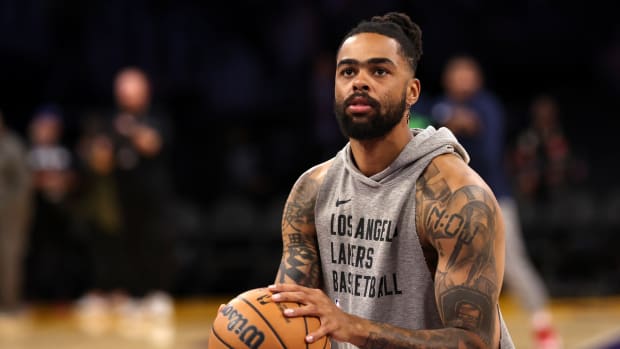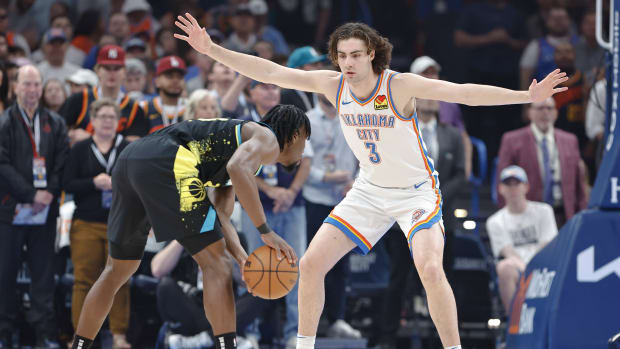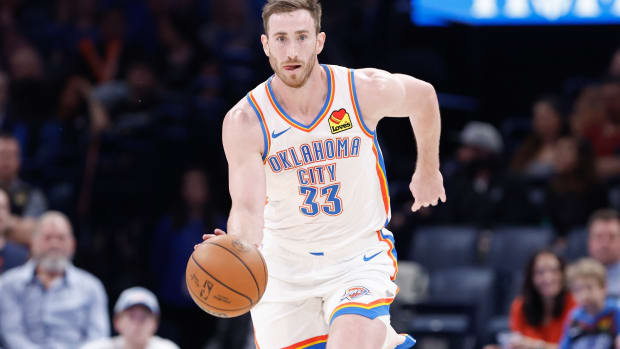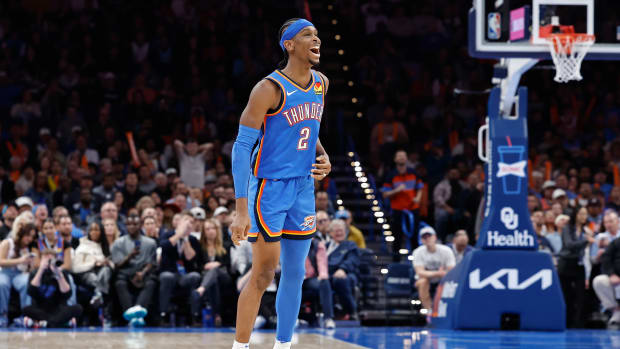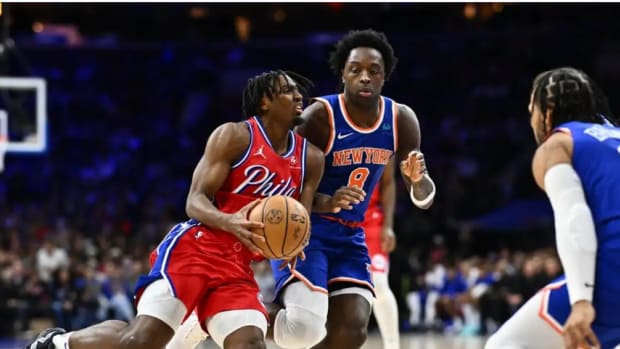Adam Silver Opens Up About the NBA Bubble: 'It’s Better Than What We Had Envisioned'
From behind two inches of plexiglass, a cloth mask covering his face and NBA basketball playing out before his eyes, Adam Silver felt a wave of emotion wash over him. It had been more than four months since the COVID-19 pandemic shut the league down, when Jazz center Rudy Gobert tested positive in Oklahoma City, bringing the game to a screeching halt. Everything that followed—the countless conversations with epidemiologists, the painstaking negotiations with the players union, the barrage of criticism from those who questioned the ethics of a sports league running thousands of rapid-response tests when the surrounding communities struggled to get just one—had led to this, a socially distanced seat for the NBA’s reopener, Lakers-Clippers, an L.A. rivalry in central Florida, a marquee event playing out in front of 300 or so virtual fans. “It was a bit overwhelming to see,” Silver told Sports Illustrated. “To see our players together playing basketball, that what we had worked through over many months on paper, on our computer screens, had come to life, I’d say it was moving to me.”
The NBA bubble isn’t really a bubble. It’s a quarantined environment spread out over four hotels and three arenas, with some 1,500 people moving around in it. It isn’t cheap—the total cost will be around $170 million—but it has worked. As baseball struggles to keep teams healthy and college football crumbles, the NBA restart is humming along. Players, initially leery of a lockdown, have settled into routines. “I really worried about it potentially feeling a little bit like an armed camp,” says Michele Roberts, executive director of the NBPA. “I’ve found that our players are able to relax. I’m very impressed with the work that everyone’s done to create this thing.”
A few weeks into the restart, Silver spoke to Sports Illustrated about the most challenging season in history.
SI: The bubble—sorry, the campus—is operational. Is it what you hoped it would be?
AS: It’s better than what we had envisioned. Players have taken to it in a more spirited way than we thought they would. We knew that this would require enormous sacrifice on everyone’s part, but I think that what is hard to calibrate—and this maybe goes to my experience when I first came into the arena—is the human emotion that comes with being around other people. And I think everyone realized they missed it more than they even understood. There are players either whose teams are not participating, who were unable to engage this summer because of injuries or other issues, who, once they spoke to fellow NBA players, have asked to join the experience down in Orlando.
I think that it’s the togetherness, the camaraderie, the brotherhood of the players. That’s been the case for the coaches, the team staff and management as well. To take those masks off and bang into each other, whether it’s someone on your team or an opponent, it’s just a human craving we have for contact with other people.
SI: Looking back on the last few months, how confident were you that we would get here?
AS: It has ebbed and flowed. I mean, there have been moments of great optimism, and there have been moments of despair. And I’d say even now, my confidence still ebbs and flows. I’m very aware of how this virus continues to, in many cases, surprise even the greatest experts who’ve spent a lifetime studying coronaviruses. I also recognize that the coronavirus isn’t the only thing that we have to be concerned with here. There’s the ongoing health of the players. There are typical injuries that happen, and we’ve been very watchful to see whether there’s an unusual rate of injuries, which we haven’t seen so far. There’s also the mental well-being of our players and the rest of the community, living on a campus. It’s been roughly three weeks so far, but for those teams that ultimately end up competing in the Finals for the championship, if everything goes according to plan, that’s still more than, well, roughly two months away, so it’s a long time of relative isolation.
SI: As you pieced this plan together, was there one issue you kept coming back to?
AS: Testing. How those protocols would work in terms of daily testing, whether we were comfortable that sufficient tests were available, that we were not taking those tests away from the surrounding community, that we could turn those tests around on a rapid-enough basis to make it workable in the community. Something we’re still dealing with is how we would handle false positives, and also the recognition that statistically you’re going to get false negatives along the way, too.
SI: Anything you wish you could have done?
AS: I’d say my biggest disappointment is that we couldn’t find a sensible way to bring 30 teams down there. We know everything here involves compromises, but I do feel bad there are eight teams that are not part of the experience.
SI: You have said you wanted to bring the sport back for the fans. But there were huge financial consequences if the NBA didn’t come back. What would have been the fallout if the league couldn’t return?
AS: [Pauses.] I’m hesitating only because it’s better to play than not to play, but in terms of a net basis, it’s not as dramatically different as people might think, because it is so costly to do what we’re doing in Orlando. It’s not a sustainable model, but we also recognize that this virus will end and that at some point we will return to more of a normal business operation with fans in seats. But I recognize that there’s a chance that still this season could come to a halt. The league certainly would have survived had we been forced to shut down, and it will survive if we’re forced to shut down sometime before October.
SI: The NBA has been supportive of player advocacy, from messaging on the back of uniforms to relaxing rules on kneeling during the anthem. It is, frankly, not a position I think the league would have taken a few years ago. When the issue of kneeling during the anthem came up in 2017, you were pretty clear that you expected players to stand. What made this different?
AS: The killing of George Floyd has been a turning point in the movement for social justice in the United States. The league, our team owners and the players had many conversations about what was happening in our country, the fact that an estimated 25 million Americans have protested over issues around racial injustice. And, of course, there’s the recognition that roughly 80% of our players are Black. George Floyd’s killing and the protests were happening right at the time when we were negotiating the return protocols with the players, and they also felt that it was part and parcel with returning to basketball that we collectively focus on these issues.
[We’ve attempted] to engage people, regardless of race, in conversations about why it is there are such great in-equities in this country, even around this immediate health crisis. Black Americans are being hospitalized at multiple the rate that white Americans are of COVID; economic disparities are hitting Black Americans at much greater rates than white Americans in this pandemic. Our view as a league was it was part of a responsibility to respond to our players and to help use this platform of the NBA to get people to engage on what we acknowledge can be a very uncomfortable conversation.
And honestly, from a personal standpoint, I participate in some of those uncomfortable conversations at the league office directly with many of my Black colleagues, some of whom I’ve worked with for decades who were saying things to me that maybe they never felt comfortable saying to me in the past. In some cases it was about personal life experiences they had, which they hadn’t shared, and in other cases was how they were experiencing the NBA as a Black league official. I found myself in some cases becoming very defensive in those conversations, but I was also forcing myself to listen. Collectively we felt that these are conversations are ones that we need to be having as a country.
We were not in a position, given that we were attempting to return to play in the middle of all the social unrest, to avoid being part of the conversation . . . given that some of the most high-profile Black people in the world play in the NBA.
SI: Is the criticism that comes with the NBA’s embracing this position, from conservative networks and politicians, just the cost of doing business?
AS: To be honest, it makes me uncomfortable. I understand critics who say that they turn to sports to avoid controversy. But it’s unavoidable at this moment in time in our country. I wish there was an easier path for us to follow right now. Even if there were, I don’t think it would necessarily be the responsible thing to do.
I think our fans are able to separate words on the floor or messages on the players’ jerseys or the floor. Even to the extent that they don’t, I think they recognize that these are not simple times. Our players are not one-dimensional people, and they can both be deeply concerned about issues that our country faces and at the same time perform their craft at the highest level.
SI: You mentioned next season. How deep into the planning stages are you? Is it bubble or bust, at this point, if the landscape hasn’t changed?
AS: We are deep into the planning stages, but only to the extent that we have dozens of permutations as we look into next season. It’s certainly not bubble or bust. Our first and highest priority would be to find a way to have fans in our arenas. We’re continuing to look at all the different testing methods. We are current on vaccine developments and antivirals and other protocols around the possibility of bringing people together in arenas. We’re studying what colleges are doing as they look to bring thousands of students back on campus. We’re going to try to find the right balance between waiting as long as possible, so we have the best possible information at the time we’re making the decision, and recognizing that, at some point, we have to begin to lock in plans. We would like to find a way to play in front of fans, but it’s just too early to know how realistic this is.
I have to say though, I would not bet against American ingenuity. Just because of how high-profile our experience in Orlando is right now, we are in conversation with dozens of testing companies. We’re studying all kinds of new, relatively inexpensive, rapid tests. The extent those tests are successful and coming to market, that will also open up more possibilities for us in bringing fans into arenas, even prevaccine.
SI: Has putting all this together been easier or harder with a newborn in your life?
AS: [Laughs.] In some ways, easier. The silver lining—no pun intended—has been that. My wife and I had a child in the middle of this, in mid-May, a new daughter. And that’s the time of year where I would have been on the road. There’s no doubt I would have spent some time at home, but it probably wouldn’t have been more than a week in the middle of the playoffs. And so the fact that I’ve been around not just my newborn, but also my three-year-old daughter, and watching her develop over the last four months, having the opportunity to spend time with her every day, having her sort of sit on my lap for a lot of the Zoom calls, despite all the difficulties over this period, has been a real joy in my life.

































